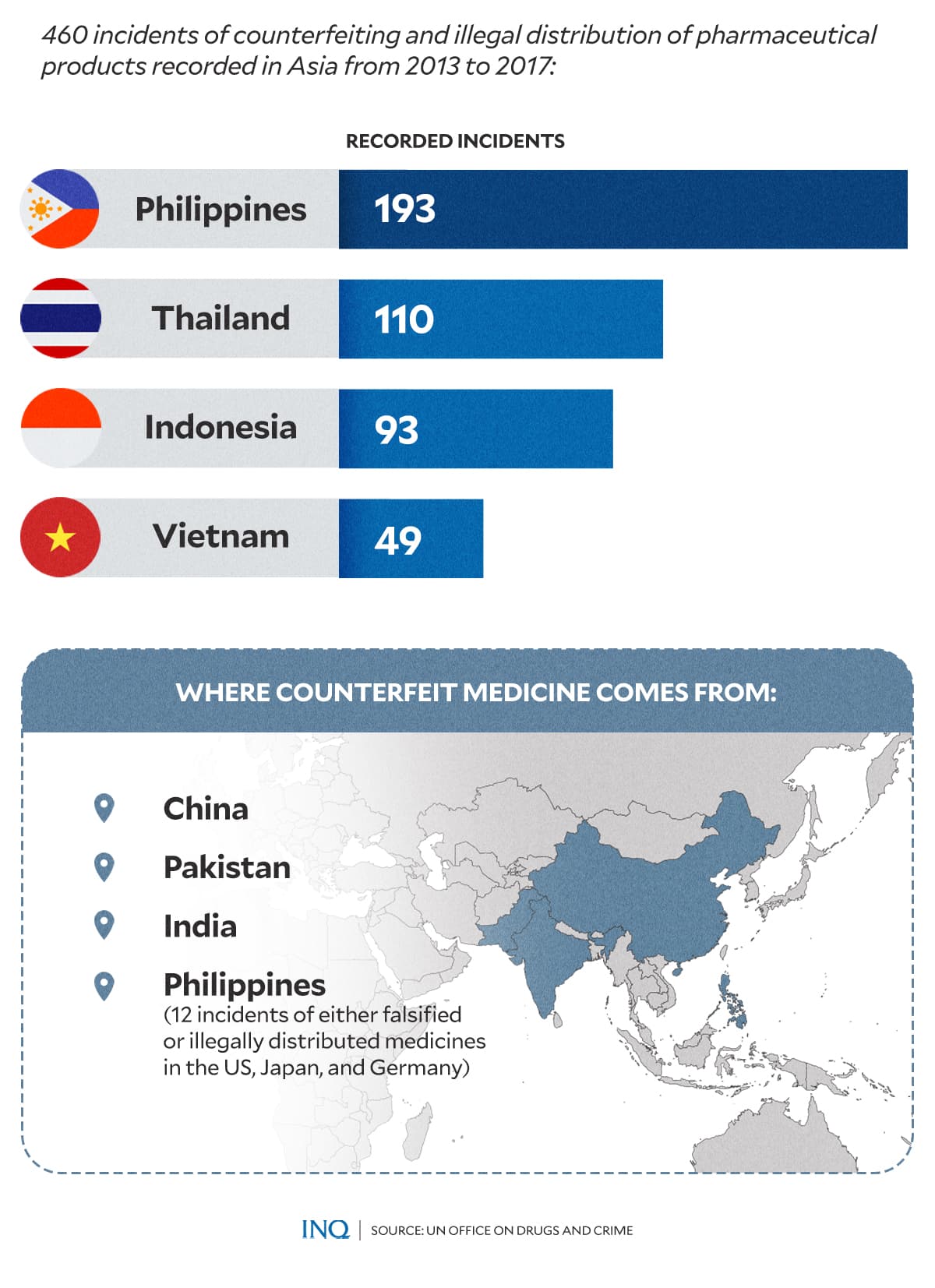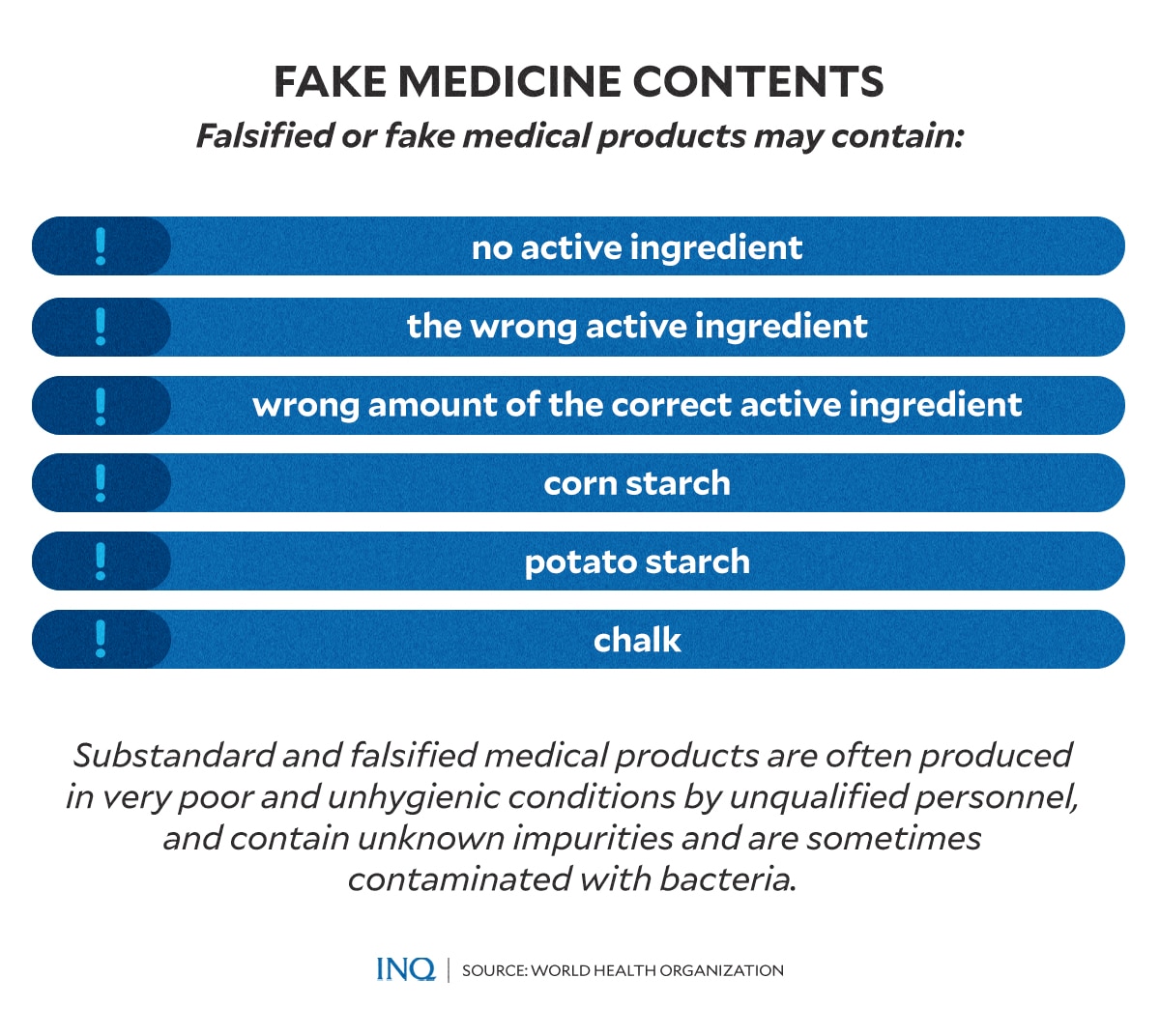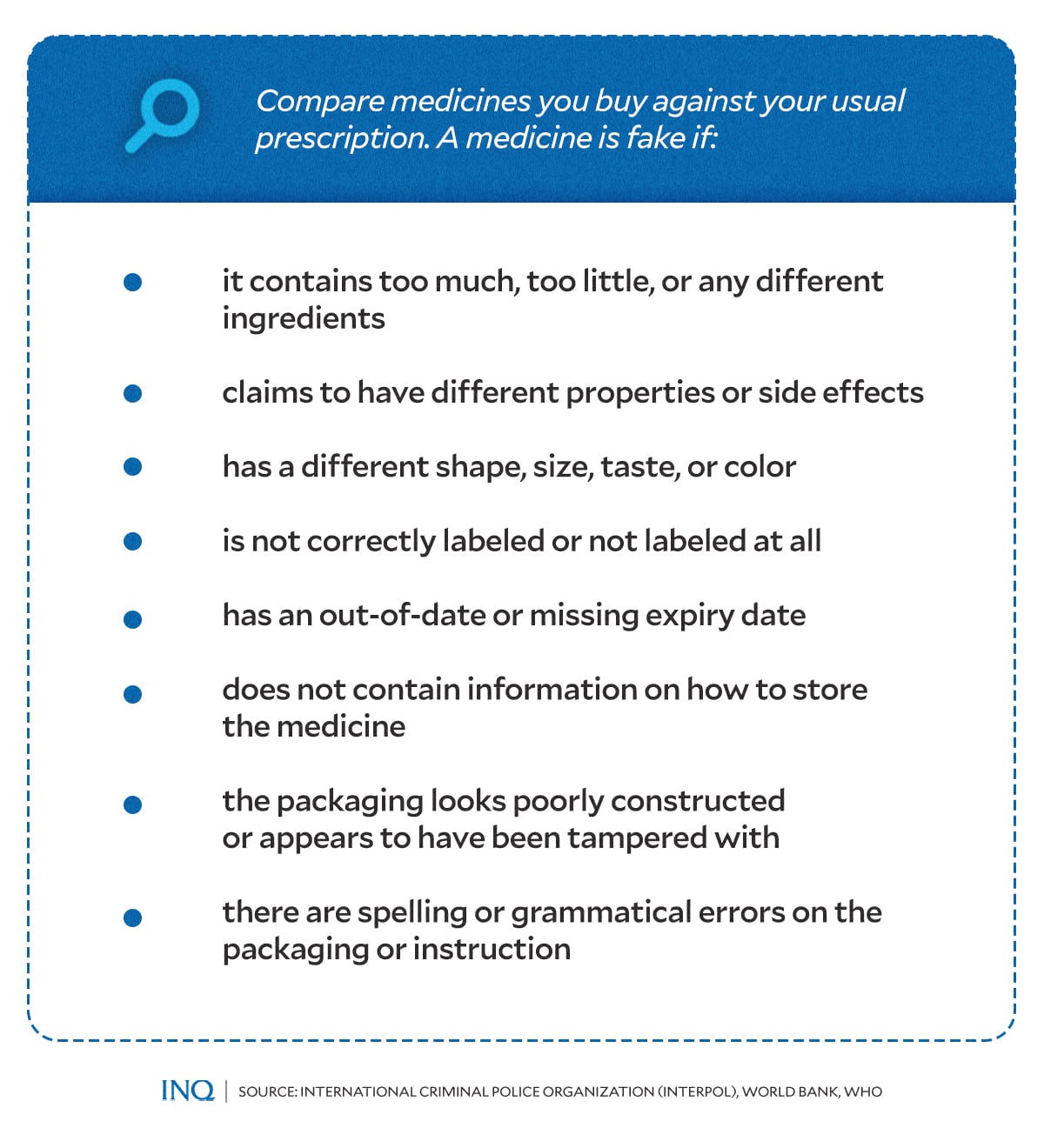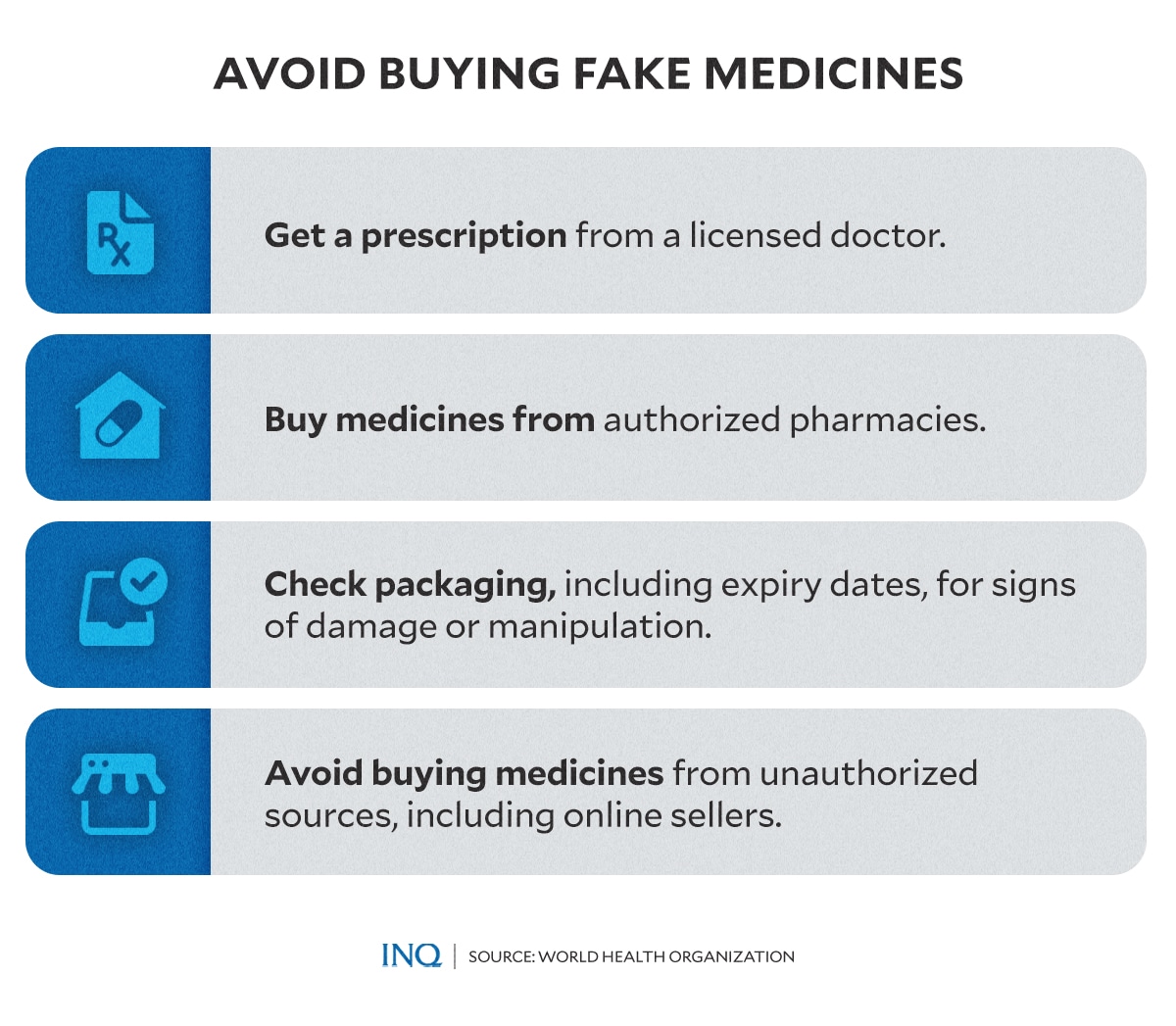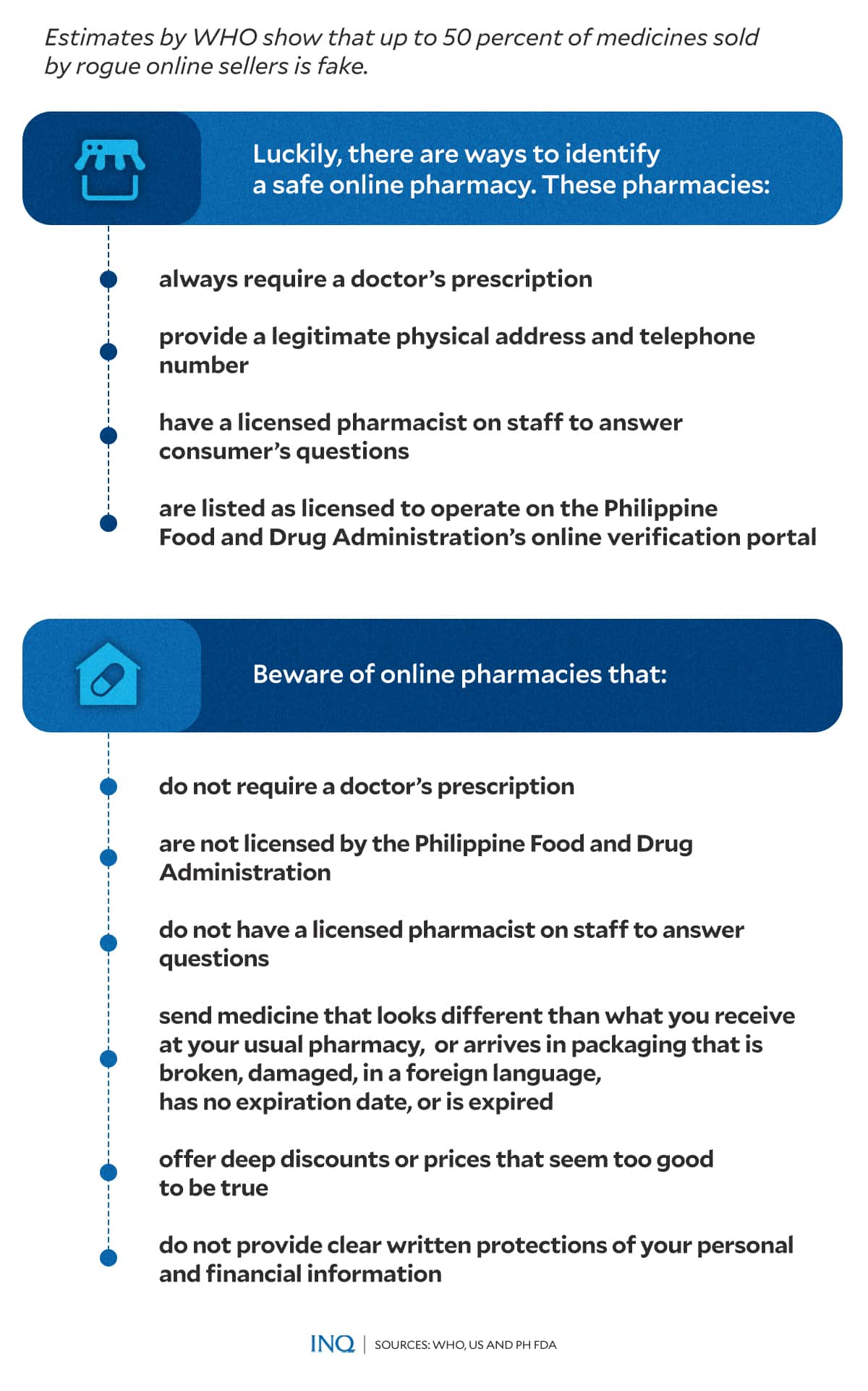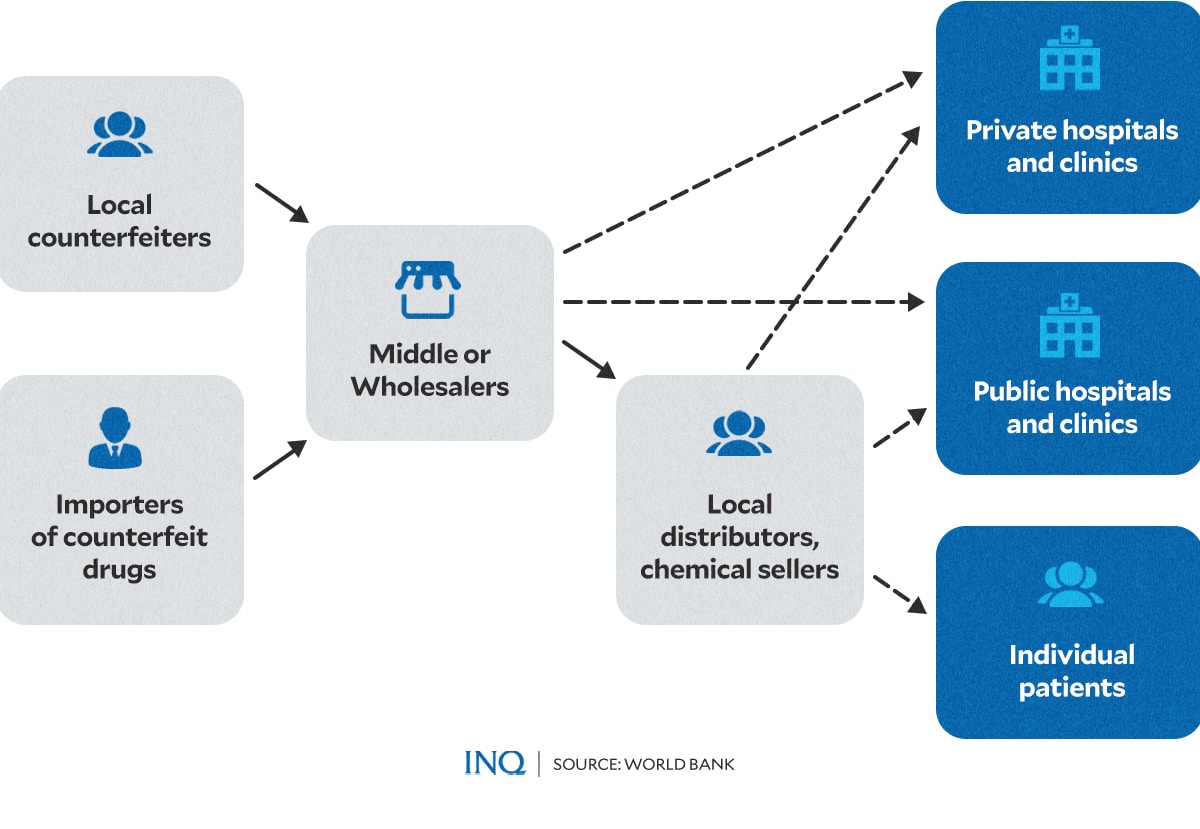MANILA, Philippines—The Food and Drug Administration’s (FDA) recent discovery of counterfeit versions of commonly used over-the-counter (OTC) medication has brought to light the continuing threat of fake medicines in the Philippines and elsewhere.
This comes years after the United Nations Office on Drugs and Crime (UNODC) identified the Philippines as a hot spot for falsified medicines in Southeast Asia.
Fake OTC drugs
In May 2023, the FDA issued a new warning urging the public to be cautious when purchasing OTC medication. This came after the discovery of counterfeit versions of Kremil S, Alaxan FR, Biogesic, Medicol Advance, Bioflu, and Tuseran Forte, all manufactured by the pharmaceutical company Unilab.
The World Health Organization (WHO) defines counterfeit, falsified, or fake medicines or medical products as medical products that are deliberately made as fake copies of the original branded or generic drugs, imitating design, colors, and other visible features.
These are usually marketed to deceive buyers about the content of what they are buying.
Counterfeit medicines include misbranded — spurious, fake, or falsely labeled — products and those that do not contain what they purport to – i.e., medicines in which the active ingredients are inert, are less than, more than, or different from what is indicated, or have expired.
They are available in both formal and informal settings, including hospitals, pharmacies, street vendors, and online marketplaces.
“All health care professionals and the general public are hereby warned as to the availability of these counterfeit drug products in the market, which [poses] potential danger or injury to consumers. Consumers are also reminded to purchase drug products only from FDA-licensed establishments,” the FDA said.
Selling counterfeit drugs is a crime under Republic Act No. 9711, also known as the FDA Act of 2009, and RA 8203, or the Special Law on Counterfeit Drugs. Anyone caught with fake medicines could be sentenced to a minimum of six months and one day in prison.
READ: FDA: 6 widely used OTC drugs faked, sold publicly
If an illness, physical injury, or suffering was worsened due to the use of counterfeit drugs, the punishment for violators is imprisonment for at least 12 years to 15 years and a fine ranging from P100,000 to P500,000.
In case the use of counterfeit drugs results in the death of an individual who unknowingly purchased and consumed them, the penalty is life imprisonment and a fine ranging from P500,000 to P5 million.
This kind of warning, however, is not new.
For years now, the Philippines has been just one of the many countries being affected by the worrying influx of counterfeit or falsified medicines entering the market and eventually ending up in the hands — and inside the body — of many consumers.
Increasing fake medicines
A 2019 report by the UNODC revealed that between 2013 and 2017, Southeast Asia recorded 460 pharmaceutical crime incidents, including counterfeiting.
The Philippines was the most affected, with 193 documented cases, followed by Thailand with 110, Indonesia with 93, and Vietnam with 49.
The UN agency said that genito-urinary therapeutic products (such as erectile dysfunction medication), central nervous system (CNS) drugs, and anti-infectives were the most frequently counterfeited.
UNODC identified Pakistan, India, and China as the primary source countries for counterfeit medicines found in the Philippines during this period. Thailand, the US, Bangladesh, and seven other countries were also noted as sources.
The Philippines, however, has also been identified as a source of counterfeit or diverted medicines in 12 cases detected in the United States (5 cases), Japan (4), and Germany (3).
According to the Philippines’ FDA, locally manufactured counterfeit OTC medicines and antituberculosis drugs have been significant concerns in the past years. In 2018, fake paracetamol tablets emerged as a growing threat in the country.
To make things worse, the COVID-19 pandemic has led to a surge in counterfeit medical products, including face masks and medicines, particularly OTC drugs. As COVID-19 cases continued to rise globally, counterfeiters took advantage of market vulnerabilities to expand their illegal operations.
In November 2021, the Philippines’ Bureau of Customs (BOC) confiscated counterfeit medicines valued at approximately P50 million from a warehouse in Pasig City.
READ: Customs agents seize P30 million worth of fake medicines; nab suspect
Just months after, in January 2022, Customs seized another P30 million worth of counterfeit over-the-counter drugs, including fake paracetamol, following reports of a shortage of flu medications in pharmacies.
Harmful, fatal ‘medicines’
According to WHO, one in 10 medical products circulating in low- and middle-income countries is either substandard or fake.
“This means that people are taking medicines that fail to treat or prevent disease. Not only is this a waste of money for individuals and health systems that purchase these products, but substandard or falsified medical products can cause serious illness or even death,” said WHO.
What does falsified or counterfeit medicine contain anyway?
Falsified or counterfeit medicines can vary significantly in composition. Some may contain no active ingredient at all, while others might have the wrong active ingredient or an incorrect amount of the correct active ingredient.
According to the WHO, many counterfeit medicines often include substances like corn starch, potato starch, or chalk.
WHO also emphasizes that some substandard or fake medical products are toxic, containing either dangerous levels of the incorrect active ingredient or other harmful chemicals.
In some cases, pollen, cement, as well as toxic substances such as rat poison and arsenic have been found in counterfeit medicines.
In a recent statement, Unilab stressed that if patients or consumers ingest toxic ingredients from counterfeit medicines for an extended period, it “can develop into serious health conditions and may lead to hospitalization or death.”
These products are frequently manufactured in poor, unhygienic conditions by unqualified personnel, leading to unknown impurities and potential bacterial contamination.
“Substandard and falsified medical products are by their very nature difficult to detect,” said WHO.
“They are often designed to appear identical to the genuine product and may not cause an obvious adverse reaction, however they often will fail to properly treat the disease or condition for which they were intended, and can lead to serious health consequences including death,” they added.
How to spot fake medicine
The International Criminal Police Organization (Interpol), along with the World Bank and the WHO, has separately released helpful guidelines for consumers to spot fake or counterfeit medicines.
According to these organizations, consumers must be observant when buying medicine. One tip is to compare the medicines they have recently bought against their usual prescriptions.
Interpol said the medicine is likely fake if:
- it contains too much, too little, or any different ingredients
- claims to have different properties or side effects
- has a different shape, size, taste, or color
- is not correctly labeled or not labeled at all
- has an out-of-date or missing expiry date
- does not contain information on how to store the medicine
- the packaging looks poorly constructed or appears to have interfered with
- there are spelling or grammatical errors on the packaging or instruction
Moreover, the public is advised to look for the lot or batch numbers of the medicines, which is essential and useful for the products’ verification process.
The FDA, meanwhile, reminded consumers to purchase medicine and other health products only from government-licensed pharmacies and to make sure that they have the appropriate FDA marketing authorization.
Consumers are also urged to report the sale or distribution of unregistered and counterfeit health products in the country.
Avoiding fake pharmacies, medicines online
The US FDA has also issued a warning advising against purchasing medications from online pharmacies or websites.
“[T]here are many unsafe online pharmacies that claim to sell prescription drugs at deeply discounted prices, often without requiring a prescription,” the US regulatory board said.
“These internet-based pharmacies often sell unapproved, counterfeit or otherwise unsafe medicines outside the safeguards followed by licensed pharmacies,” it added.
The US FDA advised the public to beware of online pharmacies that:
- do not require a doctor’s prescription
- are not licensed by the Philippine Food and Drug Administration
- do not have a licensed pharmacist on staff to answer questions
- send medicine that looks different than what you receive at your usual pharmacy or arrives in packaging that is broken,
- damaged, in a foreign language, has no expiration date, or is expired
- offer deep discounts or prices that seem too good to be true
- do not provide clear written protections for personal and financial information
Fortunately, there are ways to identify a safe online pharmacy. Such pharmacies:
- always require a doctor’s prescription for regulated medicines
- provide a legitimate physical address and telephone number
- have a licensed pharmacist on staff to answer consumer’s questions
- are listed as licensed to operate on the Philippine Food and Drug Administration’s online verification portal
In 2019, a former FDA official in the Philippines said the booming industry of online sales, particularly of medicines, is making it difficult for the government to combat the prevalence of counterfeit drugs.
Last year, the country’s FDA said it would intensify its crackdown against unregistered products and counterfeit medicines being sold online, including bogus endorsements featuring celebrities or prominent doctors.
“The growth in e-commerce and advertising on social media, along with increasingly accessible manufacturing technologies, has enabled counterfeiters to broaden and diversify the range of counterfeit goods and spare parts sold online and to distribute to customers in small parcels via postal and express freight services,” said the UNODC
“In this respect, the internet is rendering what once was a low-risk, high-profit cross-border crime into an even lower-risk and higher-profit borderless one,” UNODC added.
A pressing global issue
According to the World Bank, drug or medicine counterfeiting is a major global illicit trade driven by a combination of high financial rewards and weak regulatory environments.
A report by Andreas Seiter, then-World Bank global pharmaceutical industry fellow, detailed that at its core, counterfeiters are motivated by substantial monetary gain, capitalizing on low manufacturing costs and high profits from fake medicines.
This makes counterfeiting an appealing venture, especially in regions where enforcement is weak and penalties are minimal.
Seiter stressed that in many countries, insufficient legislation and enforcement enable counterfeiters to operate with little risk of punishment. Additionally, the relatively mild sanctions for counterfeiting, compared to harsher penalties for narcotics trafficking, further incentivize this illegal trade.
The report also detailed the intricate business model of medicine counterfeiting, which involves multiple players and stages, starting with counterfeiters who produce fake medicine. The products are then passed on to middlemen or wholesalers.
These intermediaries distribute the counterfeit products to importers, local distributors, and chemical sellers. Ultimately, the fake drugs reach private and public healthcare facilities, as well as unsuspecting individual patients.
To address this issue, Seiter suggested several policy options, including a drug regulatory authority in each country that would “establish a post-marketing surveillance program which may include early detection for counterfeit and substandard drugs in the field; periodic inspections of points in the production and distribution chain; and a rapid alert system for information sharing, action taking and product recalls.”
He added that law enforcement capacity in many countries impacted by the influx of counterfeit medicines needs to be upgraded.



